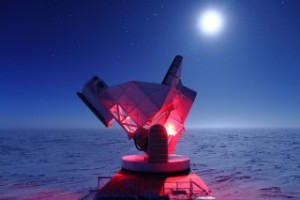Dec 16 2013
South Pole Telescope scientists have detected for the first time a subtle distortion in the oldest light in the universe, which may help reveal secrets about the earliest moments in the universe’s formation.
 Physics Review magazine has named research results published earlier this year by the South Pole Telescope collaboration as one of the top 10 physics breakthroughs of 2013. (Daniel Luong-Van)
Physics Review magazine has named research results published earlier this year by the South Pole Telescope collaboration as one of the top 10 physics breakthroughs of 2013. (Daniel Luong-Van)
The scientists observed twisting patterns in the polarization of the cosmic microwave background—light that last interacted with matter very early in the history of the universe, less than 400,000 years after the big bang. These patterns, known as “B modes," are caused by gravitational lensing, a phenomenon that occurs when the trajectory of light is bent by massive objects, much like a lens focuses light.
Early today, Physics World magazine heralded the result as one of the top 10 physics breakthroughs of 2013.
A multi-institutional collaboration of researchers led by John Carlstrom, the S. Chandrasekhar Distinguished Service Professor in Astronomy & Astrophysics at the University of Chicago, made the discovery. They announced their findings in a paper published Sept. 30, 2013, in the journal Physical Review Letters—using the first data from SPTpol, a polarization-sensitive camera installed on the telescope in January 2012.
"The detection of B-mode polarization by South Pole Telescope is a major milestone, a technical achievement that indicates exciting physics to come," Carlstrom said.
The cosmic microwave background is a sea of photons (light particles) left over from the big bang that pervades all of space, at a temperature of minus 270 degrees Celsius—a mere 3 degrees above absolute zero. Measurements of this ancient light have already given physicists a wealth of knowledge about the properties of the universe. Tiny variations in temperature of the light have been painstakingly mapped across the sky by multiple experiments, and scientists are gleaning even more information from polarized light.
Light is polarized when its electromagnetic waves are preferentially oriented in a particular direction. Light from the cosmic microwave background is polarized mainly due to the scattering of photons off of electrons in the early universe, through the same process by which light is polarized as it reflects off the surface of a lake or the hood of a car. The polarization patterns that result are of a swirl-free type, known as "E modes," which have proven easier to detect than the fainter B modes, and were first measured a decade ago, by a collaboration of researchers using the Degree Angular Scale Interferometer, another UChicago-led experiment.
B modes can't be generated by simple scattering, instead pointing to a more complex process—hence scientists' interest in measuring them. Gravitational lensing, it has long been predicted, can twist E modes into B modes as photons pass by galaxies and other massive objects on their way toward earth. This expectation has now been confirmed.
To tease out the B modes in their data, the scientists used a previously measured map of the distribution of mass in the universe to determine where the gravitational lensing should occur. They combined their measurement of E modes with the mass distribution to provide a template of the expected twisting into B modes. The scientists are currently working with another year of data to further refine their measurement of B modes.
The careful study of such B modes will help physicists better understand the universe. The patterns can be used to map out the distribution of mass, thereby more accurately defining cosmologically important properties like the masses of neutrinos, tiny elementary particles prevalent throughout the cosmos.
Similar, more elusive B modes would provide dramatic evidence of inflation, the theorized turbulent period in the moments after the big bang when the universe expanded extremely rapidly. Inflation is a well-regarded theory among cosmologists because its predictions agree with observations, but thus far there is not a definitive confirmation of the theory. Measuring B modes generated by inflation is a possible way to alleviate lingering doubt.
“The detection of a primordial B-mode polarization signal in the microwave background would amount to finding the first tremors of the Big Bang,” said the study’s lead author, Duncan Hanson, a postdoctoral scientist at McGill University in Canada.
B modes from inflation are caused by gravitational waves. These ripples in space-time are generated by intense gravitational turmoil, conditions that would have existed during inflation. These waves, stretching and squeezing the fabric of the universe, would give rise to the telltale twisted polarization patterns of B modes. Measuring the resulting polarization would not only confirm the theory of inflation—a huge scientific achievement in itself—but would also give scientists information about physics at very high energies—much higher than can be achieved with particle accelerators.
The measurement of B modes from gravitational lensing is an important first step in the quest to measure inflationary B modes. In inflationary B mode searches, lensing B modes show up as noise. “The new result shows that this noise can be accounted for and subtracted off so that scientists can search for and hopefully measure the inflationary B modes underneath,” Hanson said. “The lensing signal itself can also be used by itself to learn about the distribution of mass in the universe.”
—Emily Conover
Citation: “Detection of B-mode polarization in the Cosmic Microwave Background with Data from the South Pole Telescope,” by Duncan Hanson and the South Pole Telescope Collaboration. Physical Review Letters, Vol. 111, Issue 14, 2013.
Funding: The South Pole Telescope is supported by grants from the National Science Foundation. Support at Argonne National Laboratory for the development of SPTpol and data analysis is supported by the U.S. Department of Energy’s Office of Science. Further support of the development and construction of the SPTpol receiver were provided by the Kavli Foundation, the Gordon and Betty Moore Foundation and the National Science Foundation.